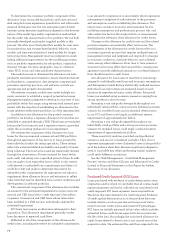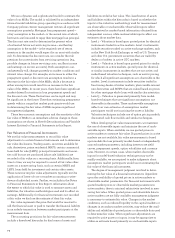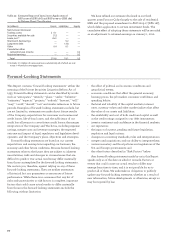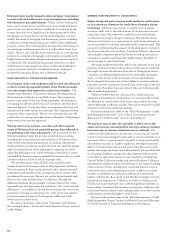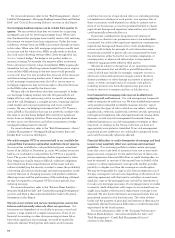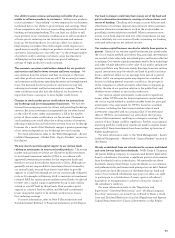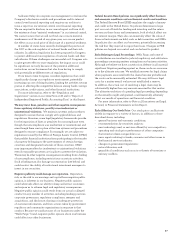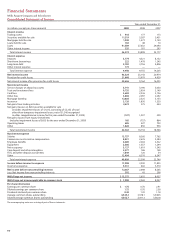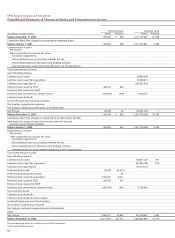Wells Fargo 2009 Annual Report Download - page 86
Download and view the complete annual report
Please find page 86 of the 2009 Wells Fargo annual report below. You can navigate through the pages in the report by either clicking on the pages listed below, or by using the keyword search tool below to find specific information within the annual report.
For more information, refer to the “Risk Management – Asset/
Liability Management – Mortgage Banking Interest Rate and Market
Risk” and “Critical Accounting Policies” sections in this Report.
Our mortgage banking revenue can be volatile from quarter to
quarter. We earn revenue from fees we receive for originating
mortgage loans and for servicing mortgage loans. When rates
rise, the demand for mortgage loans usually tends to fall, reducing
the revenue we receive from loan originations. Under the same
conditions, revenue from our MSRs can increase through increases
in fair value. When rates fall, mortgage originations usually tend
to increase and the value of our MSRs usually tends to decline,
also with some offsetting revenue effect. Even though they can
act as a “natural hedge,” the hedge is not perfect, either in
amount or timing. For example, the negative effect on revenue
from a decrease in the fair value of residential MSRs is generally
immediate, but any offsetting revenue benefit from more origina-
tions and the MSRs relating to the new loans would generally
accrue over time. It is also possible that, because of the recession
and deteriorating housing market, even if interest rates were
to fall, mortgage originations may also fall or any increase in
mortgage originations may not be enough to offset the decrease
in the MSRs value caused by the lower rates.
We typically use derivatives and other instruments to hedge
our mortgage banking interest rate risk. We generally do not
hedge all of our risk, and we may not be successful in hedging
any of the risk. Hedging is a complex process, requiring sophisti-
cated models and constant monitoring, and is not a perfect
science. We may use hedging instruments tied to U.S. Treasury
rates, LIBOR or Eurodollars that may not perfectly correlate with
the value or income being hedged. We could incur significant
losses from our hedging activities. There may be periods where
we elect not to use derivatives and other instruments to hedge
mortgage banking interest rate risk.
For more information, refer to the “Risk Management – Asset/
Liability Management – Mortgage Banking Interest Rate and
Market Risk” section in this Report.
We could recognize OTTI on securities held in our available-for-
sale portfolio if economic and market conditions do not improve.
Our securities available-for-sale portfolio had gross unrealized
losses of $5.1 billion at December 31, 2009. We analyze securities
held in our available-for-sale portfolio for OTTI on a quarterly
basis. The process for determining whether impairment is other
than temporary usually requires difficult, subjective judgments
about the future financial performance of the issuer and any
collateral underlying the security in order to assess the probability
of receiving all contractual principal and interest payments on the
security. Because of changing economic and market conditions
affecting issuers and the performance of the underlying collateral,
we may be required to recognize OTTI in future periods, thus
reducing earnings.
For more information, refer to the “Balance Sheet Analysis –
Securities Available for Sale” and “Current Accounting Developments”
sections and Note 5 (Securities Available for Sale) to Financial
Statements in this Report.
We rely on our systems and certain counterparties, and certain
failures could materially adversely affect our operations. Our
businesses are dependent on our ability to process, record and
monitor a large number of complex transactions. If any of our
financial, accounting, or other data processing systems fail or
have other significant shortcomings, we could be materially
adversely affected. Third parties with which we do business
could also be sources of operational risk to us, including relating
to breakdowns or failures of such parties’ own systems. Any of
these occurrences could diminish our ability to operate one or
more of our businesses, or result in potential liability to clients,
reputational damage and regulatory intervention, any of which
could materially adversely affect us.
If personal, confidential or proprietary information of
customers or clients in our possession were to be mishandled
or misused, we could suffer significant regulatory consequences,
reputational damage and financial loss. Such mishandling or
misuse could include, for example, if such information were
erroneously provided to parties who are not permitted to have
the information, either by fault of our systems, employees, or
counterparties, or where such information is intercepted or
otherwise inappropriately taken by third parties.
We may be subject to disruptions of our operating systems
arising from events that are wholly or partially beyond our
control, which may include, for example, computer viruses or
electrical or telecommunications outages, natural disasters,
disease pandemics or other damage to property or physical
assets, or events arising from local or larger scale politics,
including terrorist acts. Such disruptions may give rise to
losses in service to customers and loss or liability to us.
Our framework for managing risks may not be effective in
mitigating risk and loss to us. Our risk management framework
seeks to mitigate risk and loss to us. We have established processes
and procedures intended to identify, measure, monitor, report
and analyze the types of risk to which we are subject, including
liquidity risk, credit risk, market risk, interest rate risk, operational
risk, legal and compliance risk, and reputational risk, among others.
However, as with any risk management framework, there are
inherent limitations to our risk management strategies as there
may exist, or develop in the future, risks that we have not
appropriately anticipated or identified. If our risk management
framework proves ineffective, we could suffer unexpected losses
and could be materially adversely affected.
Financial difficulties or credit downgrades of mortgage and bond
insurers may negatively affect our servicing and investment
portfolios. Our servicing portfolio includes certain mortgage
loans that carry some level of insurance from one or more mort-
gage insurance companies. To the extent that any of these com-
panies experience financial difficulties or credit downgrades, we
may be required, as servicer of the insured loan on behalf of the
investor, to obtain replacement coverage with another provider,
possibly at a higher cost than the coverage we would replace.
We may be responsible for some or all of the incremental cost of
the new coverage for certain loans depending on the terms of our
servicing agreement with the investor and other circumstances.
Similarly, some of the mortgage loans we hold for investment or
for sale carry mortgage insurance. If a mortgage insurer is unable
to meet its credit obligations with respect to an insured loan, we
might incur higher credit losses if replacement coverage is not
obtained. We also have investments in municipal bonds that are
guaranteed against loss by bond insurers. The value of these
bonds and the payment of principal and interest on them may be
negatively affected by financial difficulties or credit downgrades
experienced by the bond insurers.
For more information, refer to the “Earnings Performance –
Balance Sheet Analysis – Securities Available for Sale” and
“Risk Management – Credit Risk Management Process”
sections in this Report.


